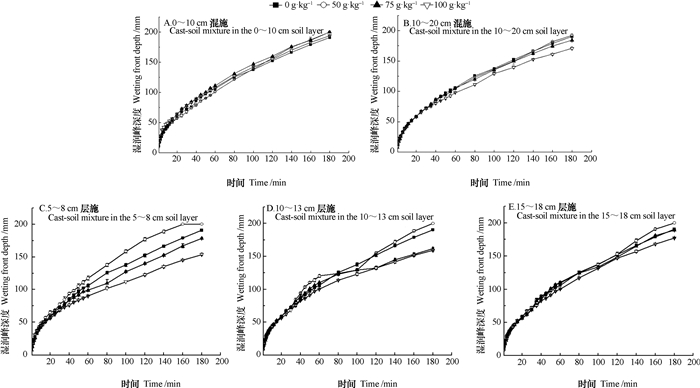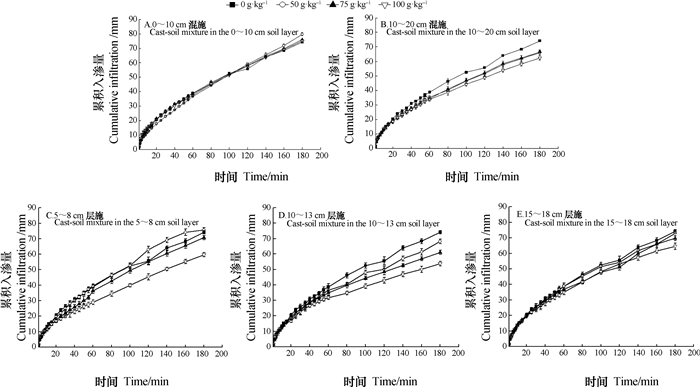2. 中国科学院地理科学与资源研究所生态系统网络观测与模拟重点实验室,北京 100101;
3. 中国科学院大学资源与环境学院,北京 100190
有机肥富含大量有益物质,肥效时间长,合理施用可提高土壤中有机质含量,为作物生长提供养分储量丰富、有效性高的生态环境[1-2],而且长期施用有机肥还可促进水稳性团聚体形成,提高土壤总孔隙度和持水孔隙度,使耕层土壤变松,表土硬度降低,提高土壤透水和保水性能[3-4]。
蚯蚓是土壤中的主要动物类群,在土壤表面和土体内部可产生大量排泄物——蚯蚓粪,蚯蚓粪是水气调和、孔隙大的团粒结构,保水保肥效果显著[5-6],施入土壤中可促进难溶性矿质养分溶解,增加土壤有效养分,且蚯蚓粪中较多的腐殖质可与黏土粒结合形成团粒,改善土壤结构[7],因而被广泛作为有机肥施入土壤[8]。目前,国内外学者针对蚯蚓粪对土壤理化性质的影响已经开展了诸多研究:王福友等[9]通过在盐碱地施加蚯蚓粪,证实蚯蚓粪可增加玉米幼苗地上部和地下部的生物量及对养分的吸收量;苏晓红等[10]指出添加蚯蚓粪可以缓解高磷土壤对油菜生长的抑制作用,增加土壤磷酸酶活性;赵鹏博等[11]将蚯蚓粪与酒糟混施加入土壤,发现土壤容重减小,有效磷、速效钾及有机质含量增高;秦芳等[12]按不同比例向土壤中添加蚯蚓粪,发现土壤pH随蚯蚓粪添加量增大而减小;李彦霈等[13]也通过研究发现覆盖于土壤表层的蚯蚓粪可抑制土壤水分蒸发,且抑制作用随覆盖面积及厚度的增大而加强。
蚯蚓粪的施用方式及用量差异会导致蚯蚓粪在土壤中空间分布的改变[14],因而会对土壤理化性状及水土过程产生不同的影响。目前的研究多集中于蚯蚓粪施用对土壤生物学特征的影响[15-19],而针对土壤水分运动方面的研究甚少。因此,本研究基于室内土柱模拟试验,通过探究蚯蚓粪施用方式及用量对土壤水分入渗过程的影响及机理,为蚯蚓粪作为有机肥的实际应用提供科学依据。
1 材料与方法 1.1 试验材料本试验以陕西关中地区塿土(褐土类,塿土亚类)为供试土壤,采自陕西杨凌水土保持研究所试验农地,去除地表杂质后,采集0~50 cm的土壤样品,清除根系等杂质后自然风干,过2 mm筛备用。土壤各粒级的体积分数分别为:砂粒5.92%,粉粒62.85%,黏粒31.23%;土壤有机质含量5.36 g·kg-1,全氮0.81 g·kg-1。
试验用蚯蚓粪由大平1号蚯蚓产生,具体收集方法为:将磨碎的树叶与土壤混合均匀后放入直径为40 cm的塑料盆钵中,在其中接种40条蚯蚓,置于温度为20℃、水分含量为100 g·kg-1~150 g·kg-1的条件下进行培养;一个月后在培养基质的表面收集蚯蚓粪,选取形状和大小相似的蚯蚓粪待用。蚯蚓粪颗粒各粒级的体积分数分别为:砂粒19.78%,粉粒59.69%,黏粒20.53%;有机质含量18.92 g·kg-1,全氮8.77 g·kg-1。
1.2 试验方法将风干后的土样按容重1.3 g·cm-3分层装入内径7 cm、壁厚0.5 cm、高22.5 cm的有机玻璃管内,填装厚度为20 cm,装土前在土柱底部垫上滤纸及纱布,防止土壤颗粒流失。管壁均匀涂抹一层凡士林以减少管壁效应对水分入渗的影响。农田有机肥的施用方法包括撒施、条施、穴施等多种形式,为探究蚯蚓粪施用方式及施用量对土壤水分入渗过程的影响,本研究设置了3种不同的施用量:蚯蚓粪在干土中的质量分别为50 g·kg-1、75 g·kg-1、100 g·kg-1,并分别以5种不同方式施用,用于模拟撒施后翻耕、施后覆土和翻土后施肥等不同方式,具体方法为:A. 0~10 cm蚯蚓粪与土壤混合填装;B. 10~20 cm蚯蚓粪与土壤混合填装;(A和B下文统称为混施)C. 5~8 cm铺设蚯蚓粪;D. 10~13 cm铺设蚯蚓粪;E. 15~18 cm铺设蚯蚓粪(C、D、E下文统称为层施)。试验以不添加蚯蚓粪的处理作为对照(裸土),共计16个处理,每个处理设置3个重复。
试验采用一维定水头垂直积水入渗法测定土壤入渗过程。由高40 cm、内径5 cm的马氏瓶向土柱供水,瓶身用刻度尺进行标注,水头高度控制在2 cm。入渗过程开始后,记录马氏瓶的水面高度及湿润锋的深度,时间间隔前密后疏,共测定180 min。入渗结束30 min后,用内径1 cm、长30 cm的土钻从表层向下每4 cm取土样,并用烘干法测定各土层样品的含水率。上述试验均在黄土高原土壤侵蚀与旱地农业国家重点实验室内进行。
1.3 数据处理试验中所有数据均为各重复测定的平均值,采用Microsoft Excel 2007和SPSS 22.0计算各变量的描述性统计特征值及进行单因素方差分析;利用Origin 8.5完成制图。
采用Kostiakov模型对实测累积入渗量随时间的变化过程进行拟合,Kostiakov入渗经验公式表达式为:
| $ I\left( t \right)=\text{K}{{t}^{\text{n}}} $ | (1) |
式中,I(t)为累积入渗量,mm;t为入渗时间,min;K和n为经验常数。
2 结果与讨论 2.1 蚯蚓粪施用方式及用量对湿润锋运移的影响图 1显示了混施和层施情形下湿润锋随时间的动态变化。从图中可以看出,各处理湿润锋深度随时间延长而逐渐增大,但在不同施用方式下,50 g·kg-1蚯蚓粪施用量处理的湿润锋运移深度均大于裸土,其中最大差值为4.1 cm,这可能是由于蚯蚓粪具有较高的孔性,施入土壤后有利于水分入渗[20],促进了湿润锋的运移。0~10 cm混施蚯蚓粪各处理的湿润锋深度差异不显著(P > 0.05),但施用蚯蚓粪后湿润锋迁移速率高于裸土,其中,施用量为50 g·kg-1、75 g·kg-1、100 g·kg-1处理的湿润锋运移深度分别较裸土大1 cm、1 cm、0.3 cm(t =180 min)。在蚯蚓粪混施入10~20 cm土层的处理中,蚯蚓粪施用量为50 g·kg-1时湿润锋深度大于裸土,但施用量为75 g·kg-1和100 g·kg-1时,湿润锋深度则分别较裸土减小3%和11%(t =180 min),其原因可能是随着施用量不断增加,蚯蚓粪内的大孔隙对水分入渗的促进作用逐渐小于蚯蚓粪持水性能及土壤水分通道曲折对水分入渗的抑制作用。对比两种混施方式可以发现:10~20 cm混施各处理湿润锋深度均小于0~10 cm混施处理,比较蚯蚓粪和土壤的颗粒组成可以发现,蚯蚓粪含有更多的砂粒,且具有良好的团粒结构,因此,施加蚯蚓粪能够增加土壤孔隙度,当混施入0~10 cm时可使较多水分进入土壤,同时蚯蚓粪较普通土壤的有机质含量更高,因而具有良好的持水性能,在积水入渗条件下上层土壤蓄积较多水分,上层土壤的含水量高于10~20 cm混施处理,因而更有利于促进水分下移。

|
图 1 蚯蚓粪混施(A、B)和层施(C、D、E)方式不同用量处理的湿润锋动态变化 Fig. 1 Dynamics of wetting front relative to cast application rate and application depth |
当蚯蚓粪以层施方式加入土壤后,不同深度层施各处理的湿润锋深度均表现为由大到小依次为:50 g·kg-1用量、裸土、75 g·kg-1用量、100 g·kg-1用量,且75 g·kg-1和100 g·kg-1用量对水分入渗的抑制作用随施用深度增加而减小。5~8 cm层施的不同用量处理之间差异显著(P < 0.05),50 g·kg-1用量处理的湿润锋深度高出裸土5.3%,75 g·kg-1和100 g·kg-1用量处理的湿润锋深度则分别较裸土低6.3%和19.5%(t =180 min)。10~13 cm层施条件下,75 g·kg-1和100 g·kg-1用量处理之间差异不显著(P > 0.05),湿润锋运移深度分别较裸土低15.2%、16.3%(t =180 min);50 g·kg-1用量在入渗60 min后,湿润锋运移速率变小,这可能是由于蚯蚓粪施用层与土层之间存在空隙而导致界面产生毛管障碍[21],影响水分向下移动。上述结果表明:50 g·kg-1用量的蚯蚓粪层施时对水分入渗具有促进作用,但用量为75 g·kg-1和100 g·kg-1则会抑制水分下移,且抑制作用随用量增加而增强。其原因可能是施入较多蚯蚓粪(75 g·kg-1及100 g·kg-1蚯蚓粪用量)时,混合层的进水吸力大于土层,当湿润锋刚到达上界面时,基质势较小,水分无法立即进入蚯蚓粪混合层,当界面处的水分增加到一定程度,湿润锋才开始继续向下移动[22];此外,粒径较小的蚯蚓粪可能会堵塞土壤孔隙,且蚯蚓粪能够保持较多的水分,从而加剧其对土壤水分入渗的抑制作用。
2.2 蚯蚓粪施用方式及用量对累积入渗量的影响水分入渗过程达到稳定后可用稳定入渗率表征入渗能力,但在达到稳定入渗之前,常用累积入渗量表征入渗能力[23]。混施及层施情形下土壤累积入渗量随时间变化过程如图 2所示。由图 2可知,各处理在0~10 cm混施蚯蚓粪条件下的累积入渗量由高到低依次为:50 g·kg-1用量、75 g·kg-1用量、100 g·kg-1用量、裸土,但裸土与75 g·kg-1和100 g·kg-1用量处理的累积入渗量并无明显差异(P > 0.05);而在10~20 cm混施条件下,裸土的累积入渗量在整个入渗过程中则均大于施用蚯蚓粪的处理,50 g·kg-1、75 g·kg-1和100 g·kg-1用量处理的累积入渗量分别较裸土小8.2 mm、7.6 mm、11.8 mm(t =180 min)。当蚯蚓粪施入0~10 cm时,该层土壤的孔隙度和持水能力均得到了提高,不仅能够促进水分进入土壤,还能够保持较多水分,因而施用蚯蚓粪处理的累积入渗量高于裸土;此外,入渗过程受土壤含水率的影响,当蚯蚓粪施入10~20 cm土层时,水分到达蚯蚓粪层时入渗速率会减小,因而0~10 cm土层的含水率可能高于裸土,进而影响水分进入土壤。另一方面,由于蚯蚓粪形状不规则,施用过程中不同的排列重叠模式会对土壤孔隙度和孔隙分布特征产生影响[24],施用后虽然增加了土壤中的总孔隙度和大孔隙数量,但有效孔隙则可能会减少;此外,水分运动通道曲折复杂也会阻碍水分运动,当该抑制作用小于由于孔隙增加所产生的促进作用时,单位入渗历时内的入渗量就会减小[25]。

|
图 2 蚯蚓粪混施(A、B)和层施(C、D、E)不同用量处理的累积入渗量动态变化 Fig. 2 Dynamics of cumulative infiltrations relative to cast application rate and application depth |
对比不同层施深度各处理累积入渗量的变化趋势可以发现:5~8 cm层施与10~13 cm层施可明显减少75 g·kg-1和100 g·kg-1用量处理的累积入渗量,但在15~18 cm层施条件下各处理间差异不明显。对于5~8 cm层施的各处理而言,50 g·kg-1用量处理的累积入渗量在入渗的中后期明显高于裸土,入渗过程结束时,裸土、50 g·kg-1、75 g·kg-1和100 g·kg-1用量的累积入渗量分别为74.2 mm、75.7 mm、70.7 mm、59.7 mm;当蚯蚓粪施入10~13 cm土层时,各处理之间差异显著(P < 0.05),累积入渗量随蚯蚓粪施用量的增加而减小,50 g·kg-1、75 g·kg-1和100 g·kg-1用量处理的累积入渗量分别较裸土小6 mm、13.1 mm、20.3 mm;在15~18 cm层施条件下,50 g·kg-1、75 g·kg-1和100 g·kg-1用量处理的累积入渗量分别低于裸土1.7%、6.1%、12.9%。上述结果进一步证实:将蚯蚓粪施入较深土层时在一定程度上会阻碍水分入渗。
2.3 蚯蚓粪施用方式及用量对土壤入渗参数的影响从图 2中可以看到,施加蚯蚓粪各处理虽然表现出了一定的层状土入渗特征,但其累积入渗量随时间的变化规律与均质土差异不明显,因此,可采用Kostiakov模型对实测累积入渗量随时间的变化过程进行拟合,以进一步分析蚯蚓粪的施用方式及用量对土壤水分运动过程的影响。
拟合得到的不同施用方式及用量处理的土壤入渗参数及决定系数如表 1所示,从表中可以看出,模型拟合的决定系数R2在0.996~0.999之间,表明拟合结果较好。对比层施蚯蚓粪各处理的入渗参数可知,除50 g·kg-1用量蚯蚓粪在5~8 cm施用的处理外,其余各处理K值均随施用量的增加呈增长趋势,n值则随施用量增加而减小。K值越大,初始入渗率越大,n值越小,入渗率随时间衰减的过程越缓慢[26],由此可知,施用蚯蚓粪多数情况下可以增大土壤初始入渗率,并降低入渗率的减小速度。在不同施用方式及用量条件下,100 g·kg-1施用量的n值均为最小。根据拟合结果可以发现:混施条件下,75 g·kg-1和100 g·kg-1用量有利于促进前期土壤水分入渗,且促进作用随着蚯蚓粪施用量的增加而增强;5~8 cm层施蚯蚓粪会减缓前期水分入渗,而10~13 cm及15~18 cm层施蚯蚓粪时,入渗率的衰减程度随施用量的增加而减弱,这与实测结果一致。
|
|
表 1 Kostiakov模型拟合参数 Table 1 Fitting parameters of the Kostiakov model |
图 3为层施蚯蚓粪条件下不同土层土壤含水率的分布情况。从图中可以看出,5~8 cm层施条件下,添加蚯蚓粪的各处理4~8 cm土层内含水率显著高于裸土(P < 0.05),50 g·kg-1、75 g·kg-1和100 g·kg-1用量处理的土壤含水量分别高出裸土9.6%、12.9%和13.7%,16~20 cm土层在蚯蚓粪施用量为75 g·kg-1及100 g·kg-1时含水量则明显低于裸土。对于10~13 cm层施蚯蚓粪的各处理而言,50 g·kg-1、75 g·kg-1和100 g·kg-1用量处理的8~12 cm土层内含水量分别较裸土高28.3%、30.1%、31.4%,但12~16 cm土层内含水量差异不显著(P > 0.05),50 g·kg-1用量处理中16~20 cm土层含水量高于裸土及75 g·kg-1和100 g·kg-1用量处理。15~18 cm层施情形下,50 g·kg-1、75 g·kg-1和100 g·kg-1用量处理12~16 cm土层含水量较裸土分别增加了5.9%、3.6%、4.4%,但75 g·kg-1和100 g·kg-1用量处理之间差异不显著(P > 0.05),50 g·kg-1和75 g·kg-1用量处理16~20 cm土层内含水量分别较裸土高1.5%和0.9%。

|
图 3 层施蚯蚓粪对土壤含水量分布的影响 Fig. 3 Effects of application of earthworm cast on distribution of soil water content relatively cast application depth |
蚯蚓粪颗粒均匀,保水透气能力是普通土壤的3倍,将蚯蚓粪施用在土壤中能够提高土壤的孔性、排水性和持水性能[27]。在水分入渗过程中,蚯蚓粪层会蓄积大量水分,从而影响水分分布。由测定结果可知,蚯蚓粪与土壤混合层形成了一个高含水量区域,其下层土壤含水率也会相应增加,但层施用量较高的蚯蚓粪(75 g·kg-1、100 g·kg-1)则可能减少深层(16~20 cm)土壤含水量。
本试验所用土壤为塿土,其质地比较黏重,大孔隙及水分传导孔隙较少且土壤孔隙弯曲程度较高,水分在土壤中往往难以入渗[28];蚯蚓粪孔隙丰富,施入土壤中可促进有机质的分解与转化,加强土壤腐殖质的形成与富集[29],促进团粒结构的形成,增大土壤孔隙度,施入上层土壤可有效促进水分向下入渗;但蚯蚓粪自身为良好的团粒结构,保水能力强,施用量较高时则会使水分大部分蓄积在蚯蚓粪层,从而抑制土壤水分向下层入渗。
3 结论蚯蚓粪施用方式及用量差异对土壤水分入渗过程具有不同程度的影响。50 g·kg-1用量蚯蚓粪与0~10 cm土壤混合施用能够促进水分入渗,75 g·kg-1和100 g·kg-1用量蚯蚓粪混施入该层土壤能够减少累积入渗量,但对湿润锋迁移过程无明显影响;在蚯蚓粪混施入10~20 cm土层情形下,只有用量达到100 g·kg-1后才能显著延缓水分入渗过程。不同蚯蚓粪施用方式及用量条件下的土壤水分入渗过程可用Kostiakov入渗经验公式进行描述,拟合结果表明,添加75 g·kg-1和100 g·kg-1用量的蚯蚓粪可增加初始入渗率,而将蚯蚓粪施入较深土层则能够降低入渗率的减小速度。蚯蚓粪以层施方式加入土壤后,多数情况下可提高其下层的土壤水分含量,但用量较多时则可能会延缓水分入渗过程,从而导致深层土壤含水率相对偏低。
| [1] |
云玲. 有机肥对土壤理化性质的影响. 农业与技术, 2010, 30(3): 65-66. Yun L. Effect of organic fertilizer on soil physical and chemical properties (In Chinese). Agriculture and Technology, 2010, 30(3): 65-66. DOI:10.3969/j.issn.1671-962X.2010.03.018 (  0) 0) |
| [2] |
龚伟, 颜晓元, 王景燕. 长期施肥对土壤肥力的影响. 土壤, 2011, 43(3): 336-342. Gong W, Yan X Y, Wang J Y. Effect of long-term fertilization on soil fertility (In Chinese). Soils, 2011, 43(3): 336-342. (  0) 0) |
| [3] |
王改兰, 段建南, 贾宁凤, 等. 长期施肥对黄土丘陵区土壤理化性质的影响. 水土保持学报, 2006, 20(4): 82-89. Wang G L, Duan J N, Jia N F, et al. Effects of long-term fertilization on soil physical and chemical property in loess hilly area (In Chinese). Journal of Soil and Water Conservation, 2006, 20(4): 82-89. DOI:10.3321/j.issn:1009-2242.2006.04.019 (  0) 0) |
| [4] |
王慎强, 李欣, 徐富安, 等. 长期施用化肥与有机肥对潮土土壤物理性质的影响. 中国生态农业学报, 2001, 9(2): 77-78. Wang S Q, Li X, Xu F A, et al. Effects of long-term use of organic manure and chemical fertilizer on fluvo-aquic soils physical quality (In Chinese). Chinese Journal of Eco-Agriculture, 2001, 9(2): 77-78. (  0) 0) |
| [5] |
胡艳霞, 孙振钧, 程文玲. 蚯蚓养殖及蚓粪对植物土传病害抑制作用的研究进展. 应用生态学报, 2003, 14(2): 296-300. Hu Y X, Sun Z J, Cheng W L. Advances in vermiculture and inhibition of vermicompost to soil-borne disease (In Chinese). Chinese Journal of Applied Ecology, 2003, 14(2): 296-300. DOI:10.3321/j.issn:1001-9332.2003.02.031 (  0) 0) |
| [6] |
王凤艳. 蚯蚓粪对土壤的影响. 吉林农业, 2005(10): 25. Wang F Y. Effects of earthworm cast on soil (In Chinese). Agriculture of Jilin, 2005(10): 25. DOI:10.3969/j.issn.1674-0432.2005.10.028 (  0) 0) |
| [7] |
斐庆海. 蚯蚓粪的优点、作用和对土壤的影响. 农村实用科技信息, 2005(10): 18. Fei Q H. The advantages and effects on soil of earthworm cast (In Chinese). Rural Practical Science and Technology Information, 2005(10): 18. (  0) 0) |
| [8] |
董炜华, 李晓强, 宋扬. 土壤动物在土壤有机质形成中的作用. 土壤, 2016, 48(2): 211-218. Dong W H, Li X Q, Song Y. Role of soil fauna on soil organic matter formation (In Chinese). Soils, 2016, 48(2): 211-218. (  0) 0) |
| [9] |
王福友, 王冲, 刘全清, 等. 腐植酸、蚯蚓粪及蚯蚓蛋白肥料对滨海盐碱土壤的改良效应. 中国农业大学学报, 2015, 20(5): 89-94. Wang F Y, Wang C, Liu Q Q, et al. Improved effect of humic acid, earthworm protein fertilizer and vermicompost on coastal saline soil (In Chinese). Journal of China Agricultural University, 2015, 20(5): 89-94. (  0) 0) |
| [10] |
苏晓红, 高志岭, 刘建玲, 等. 蚯蚓粪和磷肥配施对油菜生长和土壤性质的影响. 河北农业大学学报, 2010, 33(3): 8-12. Su X H, Gao Z L, Liu J L, et al. Impact of wormcast and phosphorus fertilizer on rape growth and soil quality (In Chinese). Journal of Agricultural University of Hebei, 2010, 33(3): 8-12. DOI:10.3969/j.issn.1000-1573.2010.03.003 (  0) 0) |
| [11] |
赵鹏博, 郑璞帆, 李司童, 等. 蚯蚓粪与酒糟不同配比对土壤理化性质及烤烟品质的影响初探. 土壤通报, 2017, 48(3): 676-682. Zhao P B, Zheng P F, Li S T, et al. Effects of different ratios of vermicompost and vinasse on soil physical and chemical properties and quality of flue-cured tobacco (In Chinese). Chinese Journal of Soil Science, 2017, 48(3): 676-682. (  0) 0) |
| [12] |
秦芳, 苏利荣, 苏天明, 等. 蚯蚓粪对土壤理化性状及菜心硝酸盐含量的影响研究. 农业研究与应用, 2013(4): 10-16. Qin F, Su L R, Su T M, et al. Study on the effect of vermicompost on physical and chemical properties of soil and nitrate in flowering cabbage (In Chinese). Agricultural Reserch and Application, 2013(4): 10-16. DOI:10.3969/j.issn.2095-0764.2013.04.003 (  0) 0) |
| [13] |
李彦霈, 邵明安, 王娇. 蚯蚓粪覆盖对土壤水分蒸发的影响. 土壤学报, 2018, 55(3): 633-640. Li Y P, Shao M A, Wang J. Effects of earthworm cast mulch on soil evaporation (In Chinese). Acta Pedologica Sinica, 2018, 55(3): 633-640. (  0) 0) |
| [14] |
宁川川, 王建武, 蔡昆争. 有机肥对土壤肥力和土壤环境质量的影响研究进展. 生态环境学报, 2016, 25(1): 175-181. Ning C C, Wang J W, Cai K Z. The effects of organic fertilizers on soil fertility and soil environmental quality:A review (In Chinese). Ecology and Environmental Sciences, 2016, 25(1): 175-181. (  0) 0) |
| [15] |
Capowiez Y, Dittbrenner N, Rault M, et al. Earthworm cast production as a new behavioural biomarker for toxicity testing . Environmental Pollution, 2010, 158(2): 388-393. DOI:10.1016/j.envpol.2009.09.003
(  0) 0) |
| [16] |
滕明姣, 万兵兵, 王东升, 等. 蚓粪施用方式对不同品种番茄生长和土壤肥力的影响. 土壤, 2017, 49(4): 712-718. Teng M J, Wan B B, Wang D S, et al. Effects of vermicompost application modes on growth of two tomato cultivars and soil fertility (In Chinese). Soils, 2017, 49(4): 712-718. (  0) 0) |
| [17] |
Le Bayon R C, Binet F. Earthworm surface casts affect soil erosion by runoff water and phosphorus transfer in a temperate maize crop . Pedobiologia, 2001, 45(5): 430-442.
(  0) 0) |
| [18] |
申飞, 郭瑞, 朱同彬, 等. 蚓粪和益生菌配施对设施番茄地土壤线虫群落的影响. 土壤学报, 2016, 53(4): 1016-1023. Shen F, Guo R, Zhu T B, et al. Effect of combined application of vermicompost and probiotics on soil nematode communities in greenhouse tomato field (In Chinese). Acta Pedologica Sinica, 2016, 53(4): 1016-1023. (  0) 0) |
| [19] |
Benitez E, Sainz H, Nogales R. Hydrolytic enzyme activities of extracted humic substances during the vermicomposting of a lignocellulosic olive waste . Bioresource Technology, 2005, 96: 785-790. DOI:10.1016/j.biortech.2004.08.010
(  0) 0) |
| [20] |
许永利, 张俊英, 李富平. 蚯蚓粪的综合利用研究现状. 安徽农业科学, 2007, 35(23): 7179-7180. Xu Y L, Zhang J Y, Li F P. Research status of comprehensive utilization of wormcast (In Chinese). Journal of Anhui Agricultural Sciences, 2007, 35(23): 7179-7180. DOI:10.3969/j.issn.0517-6611.2007.23.085 (  0) 0) |
| [21] |
任利东, 黄明斌, 樊军. 不同类型层状土壤持水能力的研究. 农业工程学报, 2013, 29(19): 105-111. Ren L D, Huang M B, Fan J. Study on water retention capacity for drained soils with different textural layering (In Chinese). Transactions of the Chinese Society of Agricultural Engineer, 2013, 29(19): 105-111. DOI:10.3969/j.issn.1002-6819.2013.19.013 (  0) 0) |
| [22] |
王春颖, 毛晓敏, 赵兵. 层状夹砂土柱室内积水入渗试验及模拟. 农业工程学报, 2010, 26(11): 61-67. Wang C Y, Mao X M, Zhao B. Experiments and simulation on infiltration into layered soil column with sand interlayer under ponding condition (In Chinese). Transactions of the Chinese Society of Agricultural Engineer, 2010, 26(11): 61-67. DOI:10.3969/j.issn.1002-6819.2010.11.011 (  0) 0) |
| [23] |
李卓, 吴普特, 冯浩, 等. 容重对土壤水分入渗能力影响的模拟试验. 农业工程学报, 2009, 25(6): 40-45. Li Z, Wu P T, Feng H, et al. Simulated experiment on effect of soil bulk density on soil infiltration capacity (In Chinese). Transactions of the Chinese Society of Agricultural Engineer, 2009, 25(6): 40-45. DOI:10.3969/j.issn.1002-6819.2009.06.007 (  0) 0) |
| [24] |
Atiyeh R M, Edwards C A, Suler S, et al. Pig manure vermicompost as a component of a horticultural bedding plant medium:effects on physico-chemical properties and plant growth . Bioresource Technology, 2001, 78(1): 11-20. DOI:10.1016/S0960-8524(00)00172-3
(  0) 0) |
| [25] |
周蓓蓓, 邵明安. 不同碎石含量及直径对土壤水分入渗过程的影响. 土壤学报, 2007, 44(5): 801-807. Zhou B B, Shao M A. Effect of content and size of rock detritus on infiltration (In Chinese). Acta Pedologica Sinica, 2007, 44(5): 801-807. DOI:10.3321/j.issn:0564-3929.2007.05.005 (  0) 0) |
| [26] |
刘翔, 周宏飞, 刘昊, 等. 不同类型生物土壤结皮覆盖下风沙土的入渗特征及模拟. 生态学报, 2016, 36(18): 5820-5826. Liu X, Zhou H F, Liu H, et al. Characteristic and numerical simulation of sandy soil infiltration under the different types of biological soil crusts (In Chinese). Acta Ecologica Sinica, 2016, 36(18): 5820-5826. (  0) 0) |
| [27] |
周美荣, 孙振江, 申晓强. 蚯蚓粪的研究及应用. 山西农业科学, 2012, 40(8): 921-924. Zhou M R, Sun Z J, Shen X Q. Research and application of earthworm excrement (In Chinese). Journal of Shanxi Agricultural Sciences, 2012, 40(8): 921-924. (  0) 0) |
| [28] |
李帅霖, 王霞, 王朔, 等. 生物炭施用方式及用量对土壤水分入渗与蒸发的影响. 农业工程学报, 2016, 32(14): 135-144. Li S L, Wang X, Wang S, et al. Effects of application patterns and amount of biochar on water infiltration and evaporation (In Chinese). Transactions of the Chinese Society of Agricultural Engineer, 2016, 32(14): 135-144. DOI:10.11975/j.issn.1002-6819.2016.14.019 (  0) 0) |
| [29] |
单颖, 赵凤亮, 林艳, 等. 蚯蚓粪对土壤环境质量和作物生长影响的研究现状与展望. 热带农业科学, 2017, 37(6): 11-17. Shan Y, Zhao F L, Lin Y, et al. Research advances and prospective on effects of vermicompost on soil environment quality and crop production (In Chinese). Chinese Journal of Tropical Agricultural, 2017, 37(6): 11-17. (  0) 0) |
2. Key Laboratory of Ecosystem Network Observation and Modeling, Institute of Geographic Sciences and Natural Resources Research, Chinese Academy of Sciences, Beijing 100101, China;
3. College of Resources and Environment, University of Chinese Academy of Sciences, Beijing 100190, China
 2018, Vol. 56
2018, Vol. 56


